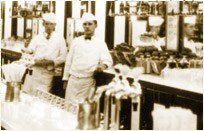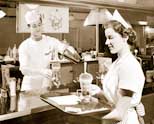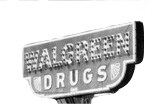"The heart of the store - the primary source of profit - was the prescription department. Walgreen filled the prescriptions and took pride in the work being done."
By 1913, Walgreens had grown to four stores, all on Chicago's South Side. The fifth Walgreens opened in 1915 and the ninth in 1916. By 1919, there were 20 stores in the rapidly-growing chain.
As impressive as this growth was, even more impressive was the superb management team that Walgreen had begun to assemble since his second store opened. Walgreen would often say - without any show of false modesty - that one of his greatest talents was his ability to recognize, hire and promote people that he considered smarter than he was. Among these early managers and executives were people who would guide Walgreens into national prominence for decades to come: William Scallion, A.L. Starshak, Willis Kuecks, Arthur C. Thorsen, James Tyson, Arthur Lundecker, John F. Grady, Roland G. Schmitt, Harry Goldstine, and later, the invaluable Robert Greenwell Knight, whom Walgreen hired from McKinsey and Company after Knight completed a visionary strategic study of Walgeen's entire operation and future.
In his ability to spot talent, Walgreen was rarely wrong. In fact, his uncanny ability to hire extended even as far as the people who manned his soda fountain, including the man who created Walgreen's next sensation.
The milkshake that shook up America
By 1920, now 20 stores strong and growing quickly, Walgreens was an established fixture on Chicago's retail scene. Throughout this decade, Walgreens underwent phenomenal growth. By 1929, the total number of Walgreens stores reached 525, including locations in New York City, Florida and other major markets. Many factors contributed to this unprecedented growth: a superb management team, modern merchandising, innovative store design, fair pricing, outstanding customer service and exceedingly high pharmacy quality and service. Yet, one can't overlook something that may have seemed a minor innovation at the time. This was the invention of Walgreens immortal malted milkshake, an instant classic, by Ivar "Pop" Coulson in 1922. Coulson was a lover of fountain creations and the backbone the Walgreens soda fountain since 1914. His chocolate malted milk was a development for the company that was anything but minor.

Coulson had always been eager to improve on whatever he and his fountain clerks had to offer, and he made generous use of Walgreens extra-rich ice cream, manufactured in Walgreen's own plant on East 40th Street in Chicago.

Until then, malted milk drinks were made by mixing milk, chocolate syrup and a spoonful of malt powder in a metal container, then pouring the mixture into a glass. On one especially hot summer day in 1922, Pop Coulson set off his revolution. To the basic mixture, he added a generous scoop of vanilla ice cream, then another.
Old Fashioned Chocolate Malted Milk
- Use a Frosted Malt Can
- 1 1/2 oz. Chocolate Syrup
- 3 - #16 Dips of Vanilla Ice Cream
- 5 1/2 oz. of Cold Milk
- Add Malt Powder (One Heaping Tablespoonful)
- Place On Mixer Only Until Mixed - Do Not Over Mix
- Use a Generous Portion of Whipped Topping In A #1808 - 10 oz. Glass
- Pour Malted Milk in Glass Approximately 2/3 Full
- Serve Remainder Of Malted In A Shaker Along With The Glass To The Guest With Straws and Package of Fountain Treat Cookies
